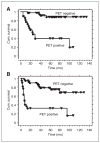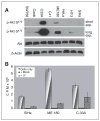Pathway-specific analysis of gene expression data identifies the PI3K/Akt pathway as a novel therapeutic target in cervical cancer
- PMID: 22235101
- PMCID: PMC3627483
- DOI: 10.1158/1078-0432.CCR-11-2485
Pathway-specific analysis of gene expression data identifies the PI3K/Akt pathway as a novel therapeutic target in cervical cancer
Abstract
Purpose: Cervical tumor response on posttherapy 2[(18)F]fluoro-2-deoxy-d-glucose-positron emission tomography (FDG-PET) is predictive of survival outcome. The purpose of this study was to use gene expression profiling to identify pathways associated with tumor metabolic response.
Experimental design: This was a prospective tissue collection study for gene expression profiling of 62 pretreatment biopsies from patients with advanced cervical cancer. Patients were treated with definitive radiation. Fifty-three patients received concurrent chemotherapy. All patients underwent a pretreatment and a 3-month posttherapy FDG-PET/computed tomography (CT). Tumor RNA was harvested from fresh frozen tissue and hybridized to Affymetrix U133Plus2 GeneChips. Gene set enrichment analysis (GSEA) was used to identify signaling pathways associated with tumor metabolic response. Immunohistochemistry and in vitro FDG uptake assays were used to confirm our results.
Results: There were 40 biopsies from patients with a complete metabolic response (PET-negative group) and 22 biopsies from patients with incomplete metabolic response (PET-positive group). The 3-year cause-specific survival estimates were 98% for the PET-negative group and 39% for the PET-positive group (P < 0.0001). GSEA identified alterations in expression of genes associated with the PI3K/Akt signaling pathway in patients with a positive follow-up PET. Immunohistochemistry using a tissue microarray of 174 pretreatment biopsies confirmed p-Akt as a biomarker for poor prognosis in cervical cancer. The phosphoinositide 3-kinase (PI3K) inhibitor LY294002 inhibited FDG uptake in vitro in cervical cancer cell lines.
Conclusions: Activation of the PI3K/Akt pathway is associated with incomplete metabolic response in cervical cancer. Targeted inhibition of PI3K/Akt may improve response to chemoradiation.
Conflict of interest statement
No potential conflicts of interest were disclosed.
Figures





Similar articles
-
Translating imaging results into tumor biology: FDG-PET and the response to chemoradiation in human cervical carcinoma.Radiat Res. 2013 Sep;180(3):223-30. doi: 10.1667/RR3392.1. Epub 2013 Jul 30. Radiat Res. 2013. PMID: 23899375
-
AKT inhibitors promote cell death in cervical cancer through disruption of mTOR signaling and glucose uptake.PLoS One. 2014 Apr 4;9(4):e92948. doi: 10.1371/journal.pone.0092948. eCollection 2014. PLoS One. 2014. PMID: 24705275 Free PMC article.
-
PAK4 confers the malignance of cervical cancers and contributes to the cisplatin-resistance in cervical cancer cells via PI3K/AKT pathway.Diagn Pathol. 2015 Sep 28;10:177. doi: 10.1186/s13000-015-0404-z. Diagn Pathol. 2015. PMID: 26411419 Free PMC article.
-
PI3K/Akt/mTOR inhibitors in cancer: At the bench and bedside.Semin Cancer Biol. 2019 Dec;59:125-132. doi: 10.1016/j.semcancer.2019.07.009. Epub 2019 Jul 16. Semin Cancer Biol. 2019. PMID: 31323288 Review.
-
The Potential Value of the PI3K/Akt/mTOR Signaling Pathway for Assessing Prognosis in Cervical Cancer and as a Target for Therapy.J Cell Biochem. 2017 Dec;118(12):4163-4169. doi: 10.1002/jcb.26118. Epub 2017 Jun 22. J Cell Biochem. 2017. PMID: 28475243 Review.
Cited by
-
Isoflurane promotes proliferation of squamous cervical cancer cells through mTOR-histone deacetylase 6 pathway.Mol Cell Biochem. 2021 Jan;476(1):45-55. doi: 10.1007/s11010-020-03884-7. Epub 2020 Aug 24. Mol Cell Biochem. 2021. PMID: 32833118 Free PMC article.
-
Research progress on the PI3K/AKT signaling pathway in gynecological cancer (Review).Mol Med Rep. 2019 Jun;19(6):4529-4535. doi: 10.3892/mmr.2019.10121. Epub 2019 Apr 3. Mol Med Rep. 2019. PMID: 30942405 Free PMC article. Review.
-
The SGK3-Catalase antioxidant signaling axis drives cervical cancer growth and therapy resistance.Redox Biol. 2023 Nov;67:102931. doi: 10.1016/j.redox.2023.102931. Epub 2023 Oct 16. Redox Biol. 2023. PMID: 37866161 Free PMC article.
-
Adenosinergic Signalling in Cervical Cancer Microenvironment.Expert Rev Mol Med. 2025 Jan 7;27:e5. doi: 10.1017/erm.2024.30. Expert Rev Mol Med. 2025. PMID: 39762204 Free PMC article. Review.
-
In vitro chemoresponse to cisplatin and outcomes in cervical cancer.Gynecol Oncol. 2013 Jul;130(1):188-91. doi: 10.1016/j.ygyno.2013.04.005. Epub 2013 Apr 10. Gynecol Oncol. 2013. PMID: 23583416 Free PMC article.
References
-
- Siegel R, Ward E, Brawley O, Jemal A. Cancer statistics, 2011: the impact of eliminating socioeconomic and racial disparities on premature cancer deaths. CA Cancer J Clin. 2011;61:212–36. - PubMed
-
- Morris M, Eifel PJ, Lu J, Grigsby PW, Levenback C, Stevens RE, et al. Pelvic radiation with concurrent chemotherapy compared with pelvic and para-aortic radiation for high-risk cervical cancer. N Engl J Med. 1999;340:1137–43. - PubMed
-
- Eifel PJ, Winter K, Morris M, Levenback C, Grigsby PW, Cooper J, et al. Pelvic irradiation with concurrent chemotherapy versus pelvic and para-aortic irradiation for high-risk cervical cancer: an update of radiation therapy oncology group trial (RTOG) 90-01. J Clin Oncol. 2004;22:872–80. - PubMed
-
- Grigsby PW, Siegel BA, Dehdashti F. Lymph node staging by positron emission tomography in patients with carcinoma of the cervix. J Clin Oncol. 2001;19:3745–9. - PubMed
-
- Schwarz JK, Grigsby PW, Dehdashti F, Delbeke D. The role of 18F-FDG PET in assessing therapy response in cancer of the cervix and ovaries. J Nucl Med. 2009;50 (Suppl 1):64S–73S. - PubMed

